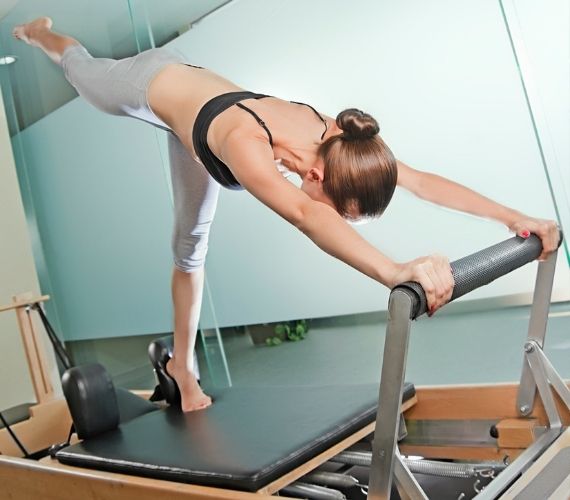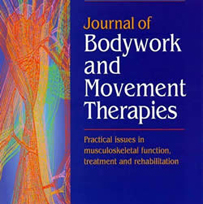
An analysis of the energy expenditure, blood lactate, and intensity of apparatus and mat Pilates sessions
by Letícia de Souza Andrade, Isabella da Silva Almeida, Luís Mochizuki, Michael David. Kennedy, João Luiz Quagliotti Durigan, Yomara Lima Mota Show all authors
Published: December 08, 2020 DOI:https://doi.org/10.1016/j.jbmt.2020.12.007
ABSTRACT
Background
Pilates is a form of exercise commonly used in rehabilitation settings that improves muscular fitness and flexibility. However, it is unknown whether the energy expenditure (EE) from Pilates sessions could also lead to the intensity suggested by health organizations to improve physical fitness.
This study aimed to quantify and compare the intensity and the EE of two different Pilates sessions (mat and apparatus).
Methods:
18 healthy females (age: 22 ± 3 years; height: 1.6 ± 0.1m; body mass: 61.0 ± 10.0 kg; body mass index: 21 ± 3 kg/m 2) performed two different sessions. Each session involved the performance of 15 exercises. Oxygen consumption ( V˙O 2) was measured continuously and then converted to EE in Kcal/min. Blood lactate, heart rate (HR), and blood pressure (BP) were also measured. A repeated measures two-way ANOVA (time X group) determined differences between sessions. Bonferroni’s post hoc analysis was used to identify significant differences between measures.
Results:
The Reformer apparatus and Mat sessions presented an EE of 2.59 ± 0.53 and 1.93 ± 0.26 kcal/min, respectively. V˙O 2 was higher for the Reformer session (8.67 ± 1.15 ml/kg/min) when compared to Mat (6.44 ± 0.73 ml/kg/min). There was no significant increase in blood lactate, HR, and BP for either session above resting values.
Conclusion:
The Pilates sessions analyzed in this study elicit low cardiovascular stress, leading to low EE levels. However, a typical session performed on the Reformer apparatus presented a higher EE, V˙O 2, and HR compared to the Mat Pilates session.>
DISCUSSION
This study aimed to investigate and compare the energy expenditure (EE), V˙O2, blood lactate, HR and BP responses during two typical sessions of Pilates. To the best of the authors’ knowledge, this is the first study to investigate and compare the direct EE during Mat and Reformer apparatus Pilates sessions. Although the literature indicates an improvement in cardiorespiratory and physical fitness with the practice of Pilates in the long term (Byrnes et al., 2018;Rayes et al., 2019;Tinoco-Fernández et al., 2016), the results of the present study show that a typical session of Pilates results in low EE, and thus, a low overall metabolic cost, when we consider the ACSM recommendations (Garber et al., 2011).
The low metabolic cost, as measured by V˙O2, resulted in a total EE per session of 130 ± 2.47 kcal for the Reformer apparatus sessions and 95 ± 2.81 kcal for Mat Pilates. Considering most Pilates practitioners would perform two to three sessions during a week, the highest total EE associated with Pilates sessions throughout a week would be estimated at approximately 390 kcal for the Reformer apparatus and 285 kcal for mat Pilates.
These values represent only about 40% and 28% of what ACSM recommends, respectively (Garber et al., 2011). This EE is far below the current recommendations of at least 1000 kcal/week expended in physical activity (Garber et al., 2011). To reach the 1000 kcal/week threshold, which is directly associated with a lower risk of cardiovascular diseases and premature mortality (Sesso et al., 2000), individuals engaged in Pilates will have to supplement their training with other activities during the week.
Considering the EE per minute, Pilates exercises have a lower EE when compared to other common resistance exercises for upper and lower limbs. For example, an EE of 3.3 kcal/min has been shown with resistance training exercises involving four sets of 10 repetitions at an intensity of 70% of the participants’ 1-maximum-repetition (1-RM) (Magosso et al., 2013).
Similarly, a protocol focused on performing five upper body exercises, using a large to small muscle group recruitment strategy and performed at 70% of 1RM is associated with an EE of 2.1 kcal/min (Mookerjee et al., 2016). It is noteworthy that this protocols had a higher energy expenditure than the Pilates sessions despite their low volume (1 to 5 exercises) when compared to the volume of exercises in this study (15 multi-joint exercises) (Magosso et al., 2013; Mookerjee et al., 2016).
Nevertheless, the EE of Pilates is very similar to what has been reported with other activities that also focus on concentration and specific breathing techniques, such as Yoga and Tai Chi Chuan (about 1.8 to 3.03 kcal/min and 1.6 kcal/min respectively) (Ray et al., 2011; Smith et al., 2015). Therefore, the EE in an exercise session seems to be related to the characteristics of the modality and the intensity at which it is practiced (Garber et al., 2011).
In this context, an increase in the intensity at which the Pilates sessions are performed would lead to increased EE. As previous research has shown, a higher training volume is also associated with greater EE (Magosso et al., 2013; Mookerjee et al., 2016). This strategy may also be of interest to Pilates practitioners who want to increase the session’s metabolic cost.
Despite the low EE, previous research has shown that the Pilates method promotes health benefits in sedentary individuals. A 10-week Mat Pilates program showed reduced heart rate, respiratory exchange ratio, and increased V˙O2 during submaximal aerobic testing performed on a treadmill (Tinoco-Fernández et al., 2016). In addition, improvements in V˙O2 at the ventilatory threshold, respiratory compensation point, and maximum effort during maximal aerobic testing performed on a treadmill were also found in overweight patients after an 8-week Pilates program (Rayes et al., 2019). As the adaptations from an exercise program are directly related to an individual’s initial fitness level, it is possible that positive adaptations for untrained and sedentary individuals may occur even with intensities that are below those recommended for health and fitness improvement (Garber et al., 2011).
Despite the possible benefits for sedentary/untrained individuals, increasing the total exercise volume increases the likelihood of aerobic fitness changes. Indeed, it has been shown that younger women have a better chance of improving their maximum V˙O2, in a program of moderate- to vigorous-intensity physical activity when exercising more (Sisson et al., 2009). Similarly, improvements in V˙O2 have also been demonstrated in sedentary, postmenopausal, and overweight women, even when the exercise program does not meet the minimal guidelines (Church et al., 2007).
As no significant changes were reported in blood lactate concentration after the exercise sessions, it seems that the oxygen delivery is enough to supply the low overall intensity of the muscular work done in a session, indicating that the anaerobic energy contribution is low. In addition, the intermittent nature of Pilates means that lactate clearance can occur in rest periods providing the low net rise in overall blood lactate. Compared to other types of activity, blood lactate during Pilates exercise (1.6 ±0.3 mmol/L for Mat Pilates and 1.5±0.3 mmol/L for Reformer apparatus) is lower than what has been reported after 30 minutes of moderate aerobic exercises (around 2 mmol/L) (Tsukamoto et al., 2016) and similar to low-intensity resistance exercises, performed with 20% of 1 repetition maximum, where lactate concentration increase to 2.1 mmol/L (Yasuda et al., 2014).
The HR and BP responses indicate that Pilates results in low cardiovascular stress. HR during Pilates exercises was increased in relation to rest. Still, these increases only led to 47% HRmax in the Mat session and 56% HRmax in the Reformer apparatus session (considering the calculation to estimate HRmax during exercise, 208 – 0.7 x age (Tanaka et al., 2001). Although the Reformer session was 15 bpm higher than Mat Pilates session, both percentages are considered the very light intensity of the exercise by ACSM, below 57% of HRmax (Garber et al., 2011). Regarding BP, diastolic and systolic BP were similar to rest.
The results corroborate what has been previously shown, that changes in BP during a session of Pilates are minimal, with measured values of 112 mmHg and 71 mmHg for systolic and diastolic BP during Pilates exercises in apparatus (Silva et al., 2014). In addition, the literature shows that the double product, which allows the assessment of cardiac work provided by an activity, seems to be low during a Mat Pilates session performed in men, about 14.000±1420mmHgxbpm (Junior et al., 2014), reaffirming that Pilates sessions may present low cardiovascular stress.
The sessions’ low intensity is likely the contributing factor for the low levels of physiological stress generated in the training sessions. However, due to the nature of the methods and its specific principles, prescribing more intense exercises in Pilates is a challenge. Therefore, the hypotheses of this study were partially correct. The Reformer apparatus Pilates session presented a higher EE, HR andV˙O2, but BP and blood lactate concentrations were similar between both sessions.
Despite the low EE of the Pilates sessions and the small overload, the present study results should not underestimate the potential benefits that Pilates might have in other health conditions. Particularly, Pilates has been shown to assist with postural stabilization, as joint stabilization is necessary during the exercises (Andrade et al., 2015). Thus, improved joint stability can be seen as a distinct benefit of participation. Besides, the method has shown health benefits by enhancing the quality of life and reducing levels of depression and anxiety in overweight and obese individuals (Vancini et al., 2017), promoting increased muscle endurance in health people (Cruz-Ferreira et al., 2011) and flexibility and dynamic balance in older adults (Barker et al., 2015). Changes in strength and gait performance have also been reported showing that Pilates may be a useful tool in reducing the risk of falls and enhancing participants’ quality of life (Bullo et al., 2015).
This is the first study investigating and comparing the direct EE, cardiovascular markers of intensity, and blood lactate during typical Mat and Reformer apparatus Pilates sessions. However, some limitations should be addressed in the present study. Although the participants were classified as sedentary or irregularly active, we highlight the lack of control of physical fitness levels since we did not use any instrument to quantify the level of physical fitness or quantify the individual maximum aerobic capacity of the participants.
Also, as only young women participated in this study, these results cannot be generalized to other populations. Investigating the effects of the Pilates method in frail or physically inactive populations might provide insight into how a low-intensity activity can still have muscular and cardiovascular benefits. Besides that, further research should aim to assess Pilates’ peripheral benefits because, despite the low metabolic cost, it is clear that some engagement of the cardiovascular system occurs, leading to an increase in blood flow to the working skeletal muscles.

Member Benefit: PAA Professional Membership includes Subscription to the JBMT
Have you signed up for your free subscription to the Journal of Bodywork and Movement Therapy yet?
Professional Instructor members with an active PAA membership have a subscription to the JBMT included with membership (lists are updated quarterly).
How to Access the JBMT
The first time you log in to the JBMT online you must claim your subscription. Thereafter you will be able to login anytime, providing your membership remains current.
Follow this link for instructions on how to access your complimentary subscription to the Journal: JBMT registration instructions

Comments are closed.